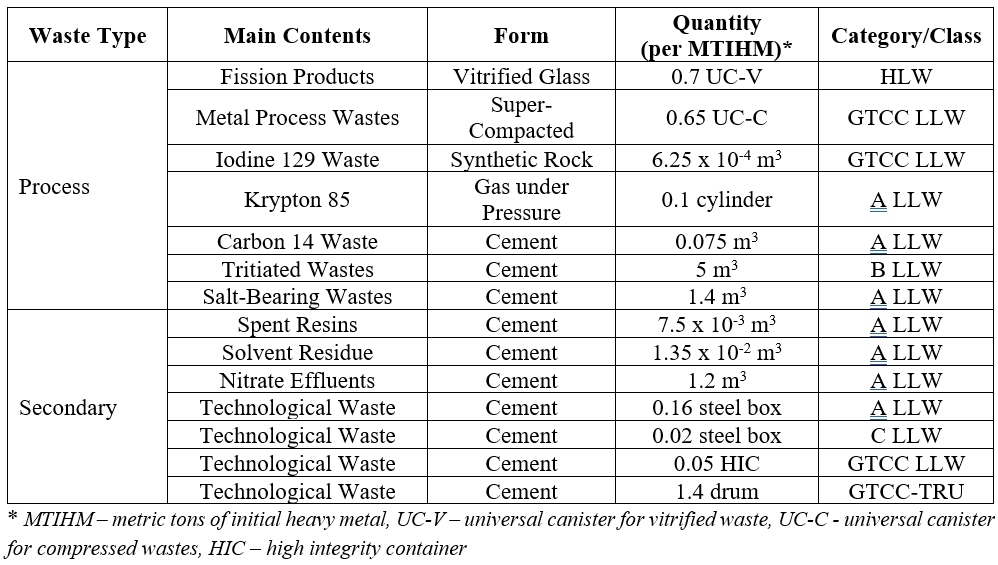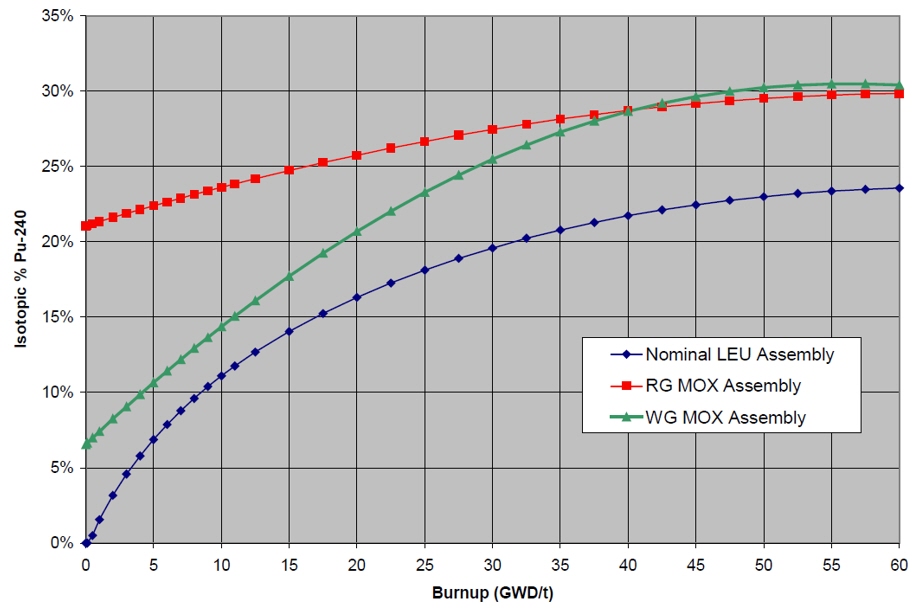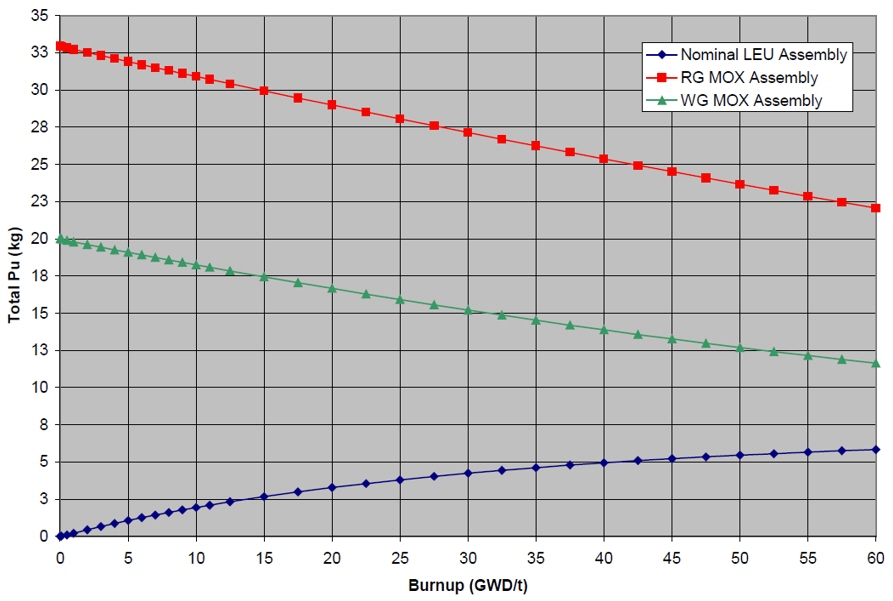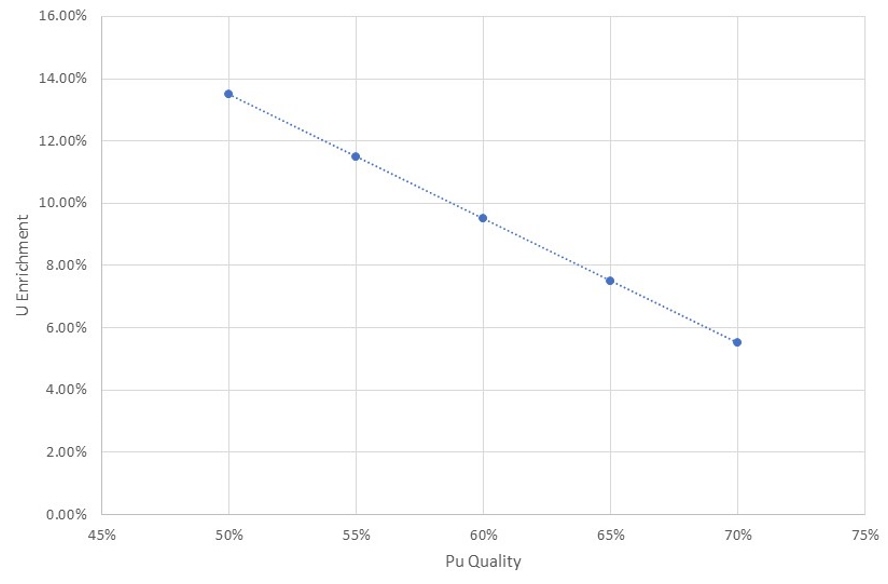Why not MOX/TRU Instead of HALEU?

AUTHORS
Sven Bader
Todd Heavner
Orano Federal Services LLC
PRESENTED
March 13, 2024
Waste Management Symposia
ABSTRACT
Recently, a reactor vendor announced a scheduling delay for its product because of an inability to procure a sufficient quantity of high assay low enriched uranium (HALEU) for its reactor in a timely manner. Although the U.S. Department of Energy (DOE)
has made progress in producing some HALEU quantities from the down-blending of highly enriched uranium (HEU) and is making efforts to support the production of larger, ideally commercially supplied quantities of HALEU, the success of these efforts
are not guaranteed. The currently produced quantities of HALEU, which are measured in the kilogram quantities, are insufficient to support the expected demand from advanced reactors, which are measured in the tens of tons quantities, and may not be
suitable for production of fuel for these reactors. As a result, an alternative fuel source known as mixed oxide (MOX), a mix between uranium oxide and plutonium oxide (could also be in a mixed metal form), or transuranic (TRU) fuel could be considered
for use in these reactors, at least in the nearer term until sufficient quantities of HALEU become available.
MOX/TRU fuel can be produced at a fuel fabrication facility designed to utilize/recycle the products produced from the reprocessing
of existing light water reactor (LWR) used nuclear fuel (UNF). Currently, these reprocessed products can be found at existing or shutdown reprocessing facilities, such as at Orano’s La Hague facility in France or from England’s Magnox
plant (shut down in 2022) and Thermal Oxide Reprocessing Plant (THORP, shut down in 2018). The DOE’s National Nuclear Security Administration (NNSA) also controls some excess Pu stockpile that were to be processed by the MOX Fuel Fabrication
Facility (MFFF) before its cancellation that could potentially be utilized to produce fuel for these advanced reactors. In addition, the DOE’s Advanced Research Projects Agency – Energy (ARPA-E), through the Converting UNF Radioisotopes
Into Energy (CURIE) program, is examining recycling activities associated with the existing LWR UNF to potentially produce fuels for advanced reactors. These current and potential future separated resources provide a nearer term solution to advanced
reactor fuel production than future commercial quantity HALEU production and potentially at a lower price (especially if currently available separated materials are utilized). In addition, the use of MOX/TRU fuels reduces the need for mining, milling,
conversion, and enrichment activities and the wastes associated with these activities.
Furthermore, if the ARPA-E CURIE program is successful, then a plentiful resource (LWR UNF) can be utilized to fuel advanced reactors while also reducing
the inventory of UNF at existing LWRs and potentially: (1) reducing the volume of waste requiring disposal; (2) producing waste forms designed for disposal; (3) reducing the need for extended interim storage of LWR UNF while eliminating potential
issues arising from the non-self-protecting nature of “old” UNF; (4) increasing the amount of domestic sourced material while reducing the need for mined material; (5) degrading the Pu isotopic vector and hence making the material less
attractive from a proliferation standpoint; (6) improving the utilization of the originally enriched uranium; and (7) moving towards closing the fuel cycle.
Orano’s experience with production of MOX fuels for LWRs has included MOX
usage in 44 LWRs globally, with the core performance equivalent to enriched natural uranium (ENU) fuels in these reactors. Orano also has extensive experience with the transportation of fresh MOX fuel assemblies to reactor sites (including the MOX
lead test assemblies sent to Duke Energy’s Catawba nuclear plant in the 2000s), allowing it to address the issues associated with moving from a Category III facility to a Category I facility (noting HALEU facilities fall into Category II). Finally,
the perceived unique nature of MOX/TRU fuels should be balanced against the fact that once ENU fuel is irradiated in a LWR core, plutonium is bred into the fuel and near the end of life, a significant fraction of the core power comes from this plutonium.
Hence, plutonium will already have been designed for in the core of an LWR and its handling already well established.
This paper will build the case for the use of MOX/TRU fuels over HALEU fuels, at least in the nearer term, in advanced
reactors until (if) HALEU becomes available in needed quantities and at reasonable costs.
INTRODUCTION
Production of commercial quantities (hundreds of tons) of HALEU in the U.S. is still likely a decade away if sufficient funding and offtake commitments are made. Currently in the U.S. only Centrus is producing HALEU and it just started this year producing
20 kilograms of HALEU with 16 of its centrifuges. In its next phase project with the DOE, Centrus is required to produce a full year of HALEU at the rate of 900 kilograms per year at its American Centrifuge Plant in Piketon, Ohio. Centrus notes that
a full-scale HALEU cascade consists of 120 centrifuges with a combined capacity to produce approximately 6,000 kilograms of HALEU per year (6 MTU/year). Centrus estimates a full-scale cascade could be producing HALEU within 42 months after securing
the necessary funding and with further appropriate support, could add a second HALEU cascade 6 months later and subsequent cascades every two months after that [1]. Hence, it is expected to take another three to four years before production of commercial
quantities of HALEU becomes available, pending sufficient funding is forthcoming.
Additionally, the cost of this HALEU may be quite significant. Consider Centrus spent more than $60 million overall (50% cost share) to produce these 20 kilograms
[1], which equates to $3 million per kilogram if no further HALEU were produced. Much of this cost was in the development of the technology to produce the HALEU and further production will result in a lower cost per kilogram of HALEU, but nevertheless
this shows the cost of production of HALEU could be quite significant. A recent price for HALEU was estimated to be approximately $32,600 per kilogram, but this is based on a conservative total program cost of $3.9 to $4.4 billion [2].
Alternative
activities to produce HALEU are occurring at U.S. National Laboratory sites, such as at Idaho National Laboratory which is producing HALEU by down-blending highly enriched uranium (HEU) recovered from the electrometallurgical treatment (EMT) of irradiated
sodium-bonded fuel from DOE research reactors. However, this HALEU must go through an additional cleanup step to reduce the dose associated with the impurities left over from the EMT process, with a final product still containing impurities that advanced
reactors may be inclined to not want to utilize. Furthermore, to date about four metric tons of HALEU metal have been produced [3], which is an insufficient quantity to supply a full core load for a power reactor.
In short, the availability
of commercial quantities of HALEU does not appear to be viable for another four years and at quite a significant cost if unsubsidized. In contrast, the materials for MOX/TRU fuel are available at existing or past reprocessing facilities, such as at
Orano’s La Hague facility in France or from England’s Magnox plant (shutdown in 2022) and Thermal Oxide Reprocessing Plant (THORP, shutdown in 2018), as well as from the NNSA and potentially from recycling facilities that are a product
of ARPA-E’s CURIE program. This paper will examine the sources of MOX/TRU, the benefits of utilizing MOX/TRU over HALEU, and the experience in use of MOX/TRU that makes it a credible alternative to HALEU.
SOURCES OF MOX/TRU
Globally, there are several operational (or nearly operational) and formerly operating reprocessing plants including Orano’s La Hague (LH) reprocessing plant, Japan Nuclear Fuel Limited’s Rokkasho reprocessing plant (RRP), and Sellafield Limited’s
Magnox and THORP reprocessing plants, which are known to have excess material suitable for production of MOX/TRU fuel. According to the International Panel on Fissile Materials, “The global stockpile of separated plutonium was about 550 tons.
Of this material, 410 metric tons were produced outside of weapon programs, covered by obligations not to use it in weapons, or not directly suitable for weapons.” [4]. In the U.S., the current stock of fissile material is estimated to include
about 87.8 tons of plutonium, a significant portion of which was intended to be processed by the MFFF into fuel for commercial LWRs before it was cancelled. This equates to approximately 1,750 PWR fuel assemblies containing MOX fuel (over 8,000 if
the global supply were available) or potentially a couple of thousand HALEU-equivalent MOX or metal fuel assemblies. This would clearly cover the 20 tons of HALEU needed for the initial cores of the TerraPower Natrium and X-Energy XE-100 reactors.
In addition, ARPA-E recently created the CURIE program that involves supporting projects with the potential to make recycling of existing LWR UNF more attractive for the production of fuels for advanced reactors. This program seeks to
take advantage of the almost 90,000 metric tons of UNF from LWRs that exists in the U.S. This program aims to develop innovative separations technologies, material accountancy, and online monitoring technologies, while minimizing waste volumes, enabling
a 1¢/kilowatt-hour (kWh) fuel cost for advanced reactor fuels, and maintaining disposal costs in the range of 0.1¢/kWh [5]. By enabling the secure and economical recycling of the nation’s inventory of LWR UNF, CURIE will improve U.S.
energy security by providing safe and sustainable domestic fuel stocks (TRU) for advanced reactors, while also helping to protect the environment and contributing to the economy.
Thus, existing MOX fuel stocks are sufficient to supply advanced
reactors with enough HALEU-equivalent material to fabricate fuel until HALEU becomes available and potential future reprocessing facilities could provide this HALEU-equivalent fuel stock (TRU) to supply advanced reactors well into the future with
simply recycling the 90,000 metric tons of UNF from LWRs in the U.S. at a cost likely lower than production of commercial quantities of HALEU.
BENEFITS OF UTILIZING MOX/TRU OVER HALEU
The use of MOX/TRU fuels has multiple advantages and a few drawbacks over HALEU. The processes needed to produce HALEU include the mining of uranium ore, the milling of the uranium ore to make uranium oxide (U3O8 form), the converting of uranium oxide
to uranium fluoride (UF6), the enrichment of the uranium, and the deconversion of UF6 to uranium dioxide. Each of these steps produces LLW and the enrichment step in particular produces significant quantities of depleted uranium hexafluoride (DUF6)
that is either interim stored or deconverted. Whereas the process to produce MOX/TRU requires the single step of reprocessing of UNF, a plentiful resource. Reprocessing of LWR UNF does produce multiple waste streams, as summarized in Table 1 [6].
This Table is based on Orano’s experience at the La Hague reprocessing facility [6,7,8,9] and can be expected to be representative of any future reprocessing facility (with likely some improvements driven by some of the ARPA-E CURIE projects).
As shown in the last column of Table 1, most of this waste is categorized as LLW, with only the vitrified fission products categorized as HLW. This HLW has been made into a form optimized for disposal (the universal canister for vitrified waste or
UC-V). Overall, the expected waste quantities for production of HALEU are expected to be greater than to produce MOX/TRU. However, all the HALEU waste is expected to be LLW that can be disposed of whereas the MOX/TRU wastes are expected to include
GTCC LLW and HLW that currently have no disposal path but are made into stable, robust waste forms suitable for interim storage until a repository becomes available.

If the ARPA-E CURIE program is successful, then a plentiful domestic resource (LWR UNF) can be utilized to fuel advanced
reactors with TRU fuel while also reducing the inventory of UNF at existing LWRs while:
- reducing the volume of waste requiring disposal as approximately 96% of the fuel is recovered for reuse in the form of ~1% Pu and ~95% U, which are ideally mixed together in some ratio (e.g., 50% Pu and 50% U) when extracted and used to produce TRU
fuel with the remaining U utilized as fuel for CANDU reactors or separately enriched to produce an alternative fuel stream for LWRs or advanced reactors. The remaining ~4% of the fuel will consist of fission products that can be solidified for
disposal;
- producing waste forms designed for disposal as the fission products are vitrified and placed into a standard waste form that simplifies handling of wastes at a disposal site as well as potentially simplifying the safety basis for the disposal site
(e.g., no criticality hazard) and eliminating the need for any safeguards;
- reducing the need for extended interim storage of LWR UNF while eliminating potential issues arising from the non-self-protecting nature of “old” UNF as the LWR UNF would be reprocessed prior to it or its interim storage system having
any potential issues associated with extended interim storage such as chloride-induced stress corrosion cracking of its storage system. In addition, the costs of having to change the protection system of an ISFSI storing non-self-protecting UNF
could be avoided if the UNF is recycled prior to this point and by reprocessing this older fuel then the regulatory limits associated with the release of Kr-85 (40CFR190) from the reprocessing plant likely can be met;
- increasing the amount of domestic sourced material while reducing the need for mined material as the approximately 90,000 MT of LWR UNF in the U.S. if reprocessed would provide a significant domestic source of MOX/TRU (approximately 18,000 MOX PWR
fuel assemblies) and as a result would clearly reduce the amount of uranium required to be mined, milled, converted, enriched, and deconverted;
- degrading the Pu isotopic vector and hence making the material less attractive from a proliferation standpoint as the Pu utilized in the form of MOX/TRU fuel in a reactor burns its odd/fissile isotopes (e.g., Pu-239) while building-up its even isotopes
and hence degrades is isotopic vector making it less attractive for proliferation purposes. This was one of the primary reasons why excess weapons-grade Pu was originally intended to be burned in LWRs. Figure 1 shows for various fuel types the
increase in the Pu-240 isotopic percentage as burnup increases (primarily at the cost of Pu-239);
- improving the utilization of the originally enriched uranium as the cost of enrichment is a significant cost of the production of fuel and hence, by recycling this fuel its additional use increases its utilization and improves the economics of the
overall fuel cycle if reprocessing can be performed cost-effectively; and
- moving towards closing the fuel cycle which should be the ultimate goal of the nuclear industry to minimize the amount of material to be disposed of in a repository that is a difficult to attain yet vital resource. Reprocessing will not eliminate the need for a repository as the ~4% of fission products to be vitrified (or otherwise solidified) will need a disposal path, which could be best suited for deep borehole disposal as detailed in [10].
There are a couple of issues unique to the use of MOX/TRU relative to HALEU and include: (1) MOX/TRU is a Category I material (10CFR73 & 10CFR74) whereas HALEU is a Category II material and LEU enriched to less than 10% U-235 is a Category III material
and hence, MOX/TRU requires a higher degree of physical security and material accounting control; (2) used MOX/TRU emits more heat than used LEU and HALEU fuel and remains hotter over longer periods of time and hence, spent fuel pool and dry storage systems
must account for the additional cooling required of this fuel; and (3) used MOX/TRU has a fissile spectrum that is further degraded than the LWR UNF making it more difficult to recycle over and over. Fortunately, each of these issues can be resolved through
improved security, increased heat removal from spent fuel pools or loading of fewer fuel assemblies in a dry storage system, and potentially mixing Pu recovered from used MOX/TRU with Pu recovered from used LEU UNF.

Figure 1. Buildup of Pu-240 as LEU, Reactor Grade (RG) MOX, and Weapons Grade (WG) MOX Fuel Assemblies are Burned Up
MOX/TRU EXPERIENCE
An oft cited concern with the use of MOX/TRU fuels is the lack of experience with the use of it in reactors in the U.S. However, the U.S. has utilized MOX fuel assemblies in its commercial reactors with the last usage occurring at Duke Energy’s
Catawba Nuclear Station in 2005 as part of the MOX program intended to convert excess weapons-grade Pu into MOX fuel for commercial reactors and thereby degrade the Pu vector to make it not suitable for any effective weapons usage. In addition to
these lead test assemblies at Catawba, MOX fuel has also been utilized in the Ginna and San Onofre PWRs and the Quad Cities, Dresden, and Big Rock Point BWRs in the 1970s. However, actually all U.S. reactors are using MOX fuel in their cores because
as the LEU fuel is burned-up, there is a buildup of Pu in this fuel as shown in Figure 2, obviously not to the level of MOX fuels as also shown in this figure, but which does account for approximately 33% of the energy produced by a reactor (i.e.,
Pu, which is less than 1% of the fuel, is producing 33% of the energy from a nuclear power plant [11]).
Furthermore, work performed on the Versatile Test Reactor (VTR) demonstrated the use of prior experience with fast reactor fuels being
incorporated into the next generation of fast reactors. During the approach to identifying sources of Pu for use in this reactor, the original fissile content of the Pu to be used in the VTR’s fuel was assumed to be approximately 70%. Unfortunately,
the existing Pu fuel stocks with this fissile content was limited to UNF from graphite reactors, which for the most part had already been recycled into MOX fuel. Hence, Figure 3 was developed to identify for the VTR a rough rule of thumb for how to
compensate for the reduced Pu fissile content with an increase in the uranium enrichment included in the U-Pu-Zr fuel. Notice from this figure that an approximately 5% decrease in the Pu fissile content requires a 2% increase in the U enrichment to
maintain the equivalent number of fissions. Since the VTR fuel is made up of 20% Pu, 70% of U, and 10% Zr, this means more fissile U content is required per unit mass to replace a reduced Pu fissile content (approximately 40% more). This is an example
of how the historical use of MOX/TRU fuel is able to inform the current planned use of MOX/TRU fuel in advanced reactors as well as the benefit of utilizing MOX/TRU over HALEU.

Figure 2. The Change in the Total Pu Content of LEU, RG MOX, and WG MOX as a Function of Burnup

Figure 3. Rough Rule of Thumb for the VTR Uranium Enrichment versus Plutonium Quality for Metal Fuel.
Finally, Orano’s experience with production of MOX fuels for LWRs through its Melox Fuel Fabrication Facility includes over 28 years of experience with more than 3,100 MT of heavy metal production for LWRs. Forty-four (44) reactors worldwide have produced nuclear electricity using MOX fuel produced from Orano (including its predecessors Areva and Cogema) since 1972. Figure 3 shows the reactors in Europe and Japan that Orano has supplied MOX fuel for in the past, noting several of which are now permanently closed (e.g., all German reactors). The core performance of this MOX fuel has essentially been equivalent to enriched natural uranium (ENU) fuels in these reactors.

Figure 4. Reactors in Japan and Europe Fueled or Designed to be Fueled with MOX Fuel.
A final area where Orano has extensive experience is with the transportation of fresh and used MOX fuel assemblies to and from reactor sites. This experience includes the shipment of the MOX lead test assemblies sent from Orano’s Melox fuel fabrication facility in France to Duke Energy’s Catawba nuclear station in the 2005 timeframe. This experience provided the opportunity to address moving a facility from Category III to Category I (noting HALEU facilities fall into Category II). This experience also included the receipt of the fresh MOX fuel assemblies through a dry or a wet receipt approach, which involves pre-refueling activities associated with the inspecting of the MOX fuel assemblies. The dry receipt activities occured at a faster rate than the wet receipt activities that involve underwater inspections of the MOX fuel assemblies, but at a reduced cumulative dose to personnel.
CONCLUSIONS
MOX/TRU fuel should be considered as an alternative to or at least a near-term fix for the lack of available HALEU fuel for advanced reactors, as it is a fuel stock that can be made available now and, if reprocessing is successfully re-introduced in the
U.S., such as through the ARPA-E CURIE program, could produce significant quantities of MOX/TRU considering the large quantity of LWR UNF in the U.S. This would be considered a domestic source of fuel material that would avoid the mining, milling,
conversion, and enrichment processes and the wastes associated with these processes that are necessary to produce commercial HALEU and avoid utilizing down-blended HEU feedstocks that may be contaminated. If the reprocessing of the LWR UNF can be
performed in an economic manner (one of the goals of the ARPA-E CURIE program), then the MOX/TRU could also present a cheaper alternative to commercially produced HALEU. In addition to these arguments, the recycling of existing LWR UNF into advanced
reactor fuels has other benefits which include reducing the volume of HLW requiring disposal, producing waste forms designed for disposal, further degrading the Pu isotopic vector to make the material even less attractive from a proliferation standpoint,
etc. Finally, there is a significant level of experience using MOX fuels in LWRs with core performance equivalent to ENU fuels.
In summation, with the current limitations associated with the availability of HALEU feedstocks in the U.S.,
advanced reactors should consider the use of MOX/TRU to meet expected timelines to commercial operation.
REFERENCES
- Centrus Energy Corp., “Centrus Makes First HALEU Delivery to U.S. Department of Energy,” November 7, 2023, https://www.centrusenergy.com/news/centrus-makes-first-haleu-delivery-to-u-s-department-of-energy/.
- Third Way, “How Much Does It Cost to Develop New Nuclear Fuel Capacity?” June 28, 2023, https://www.thirdway.org/blog/how-much-does-it-cost-to-develop-new-nuclear-fuel-capacity.
- Gateway for Accelerated Innovation in Nuclear (GAIN), “HALEU via Electrometallurgical Treatment (EMT) Process,” 2019, https://gain.inl.gov/SiteAssets/HALEU/HALEU_EMTProcessFactSheet.pdf.
- International Panel on Fissile Materials, “Fissile Material Stocks,” April 29, 2023,https://fissilematerials.org/#:~:text=The%20global%20stockpile%20of%20separated,
weapons%20or%20available%20for%20weapons. - ARPA-E, “Converting UNF Radioisotopes Into Energy (CURIE),” October 21, 2022, https://arpa-e.energy.gov/technologies/programs/curie.
- G. Foare, F. Meze, S. Bader, et al. “Waste Estimates for a Future Recycling Plant in the US Based Upon AREVA Operating Experience,” Waste Management 2013.
- S. Bader, G. Foare, et al., “Wastes Associated with Recycling Spent MOX Fuel into Fast Reactor Oxide Fuel,” ANS Global Conference 2013, Salt Lake City, UT, September 30, 2013.
- G. Foare, S. Bader, et al., “Secondary Waste Estimate for Recycling Based on AREVA Operating Experience,” ANS IHLRWM Conference April 30, 2013.
- C. Phillips, B. Willis, R. Carter, et al. (Energy Solutions) “Improving the Estimates of Wastes from the Recycling of Used Nuclear Fuel,” Waste Management 2013.
- S. Bader, “Discussion on the Merits of Deep Borehole Disposal, Especially with Recycling – 15389,” Waste Management, March 16, 2015.
- World Nuclear Association, “Plutonium,” updated August 2023, https://world-nuclear.org/information-library/nuclear-fuel-cycle/fuel-recycling/plutonium.aspx.
>> Return to Orano White Papers
